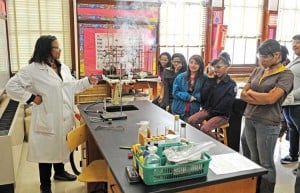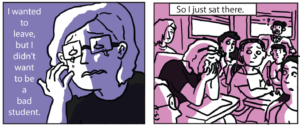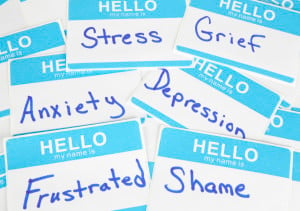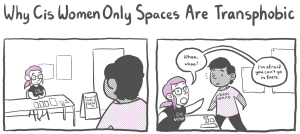
Source: Style Weekly
When I was applying to engineering schools as a high school senior, I had no idea what I was in for.
Two weeks before my college applications were due, I discovered that I was missing important standardized tests that I had not taken. The requirements for admission were listed in the fine print section of the application booklet, and if it weren’t for my desire to send in the best application possible, I would have never seen that.
Countless advisers who tried to guide me through the application process did not know these requirements either, and when I inquired about specialized standardized tests (like SAT II subject tests), I was told that they didn’t know these were even available.
The people I counted on to guide me were overwhelmed and did not understand the specific requirements to enter into an engineering program.
Because the process was so overwhelming, I was continuously discouraged from applying to an engineering school and was told instead that I could transfer at a later time.
Several times, I was told that my chances of getting admittance were slim-to-none, and that the competition would be so fierce that all my efforts would go unnoticed.
While this frustrated me, I persevered. But it doesn’t have to be that way.
Unfortunately, this is the reality of many inner-city urban schools like the one I attended.
These schools are not just underfunded, they are often ill equipped to provide students with a quality education and college preparation to help them enter into competitive college programs that can lead to careers in STEM (Science, Technology, Engineering, and Mathematics).
And while this can be similar for students in rural schools, urban schools deal with unique circumstances – like over-crowdedness, an influx of immigrant students with language barriers, and high crime rates – that create a greater hurdle for students to succeed.
STEM outreach programs are doing great work to ensure that stereotypes and biases don’t continue to hinder the success of women and people of color who wish to enter or are professionals in STEM fields.
From science-themed summer camps and coding programs to engineering toys for girls and books on female scientists, it’s evident that a lot of us care about STEM outreach, and we’re doing a great job at inspiring traditionally underrepresented youth.
However, when it comes to urban youth, we are not providing them with the tools to find success after we have piqued their interest in STEM.
But it is possible to ensure that we don’t continue to leave them behind. Here are a few ways we can do that.
1. Promote Advanced Math and Science Courses in High School
One way in which urban youths miss the mark when applying to college is by not having all of the prerequisite classes needed for specialized programs.
Science and math requirements to graduate from high school are bare minimums in the United States, with most states not requiring so-called advanced classes such as physics or calculus.
These requirements barely meet prerequisites to enter into accredited engineering and applied science programs, and sometimes they don’t meet them at all.
When I was in high school, we had no physics classes available because New York State only requires one advanced science — physics or chemistry. Because the school could only afford one teacher, we could only take one of these subjects. This turned out to be a major hindrance for me, as the colleges I wanted to attend required proficiency in both courses.
I had to ask a teacher with a mechanical engineering degree to give me classes on the weekends. He worked extra hours for free because he saw potential in me, but this isn’t even an option for many students and teachers.
This problem is exacerbated in urban schools because they are notorious for experiencing staffing difficulties, including poor teacher retention.
All of the activism to promote STEM to students still isn’t addressing the students that don’t have any choices, therefore essentially setting them up for failure. And because most students in urban schools are Latinx and Black, this sets the stage for a lack of diversity in the STEM workforce.
STEM advocates need to put more pressure on our education system and demand transformative justice for our schools.
2. Expose Students to Professionals in STEM
Urban youth are not as readily exposed to professionals working in STEM fields.
Often, parents of students in urban schools are working in blue-collar jobs and are struggling with high rent prices and a dire unemployment rate. Many of them are also new immigrants struggling with language barriers and culture shock.
Careers in STEM are not an everyday occurrence, and often, the closest person to a scientist they see are their teachers and doctors.
But, as social learning theories state, people learn by observation and modeling.
Seeing ourselves represented in the STEM workforce (as in every other case) allows us to see ourselves in that position. So it isn’t surprising that STEM careers are not on the forefront of many urban youths’ minds.
STEM activists work tirelessly to ensure that students are exposed to working professionals by hosting panels and events in schools. Even in urban schools, it isn’t unusual to see professionals coming in for career day to talk to the students about their exciting careers.
But even though meeting actual scientists, mathematicians, and engineers is super awesome, it doesn’t really help a student that still does not have necessary courses offered in their school.
Schools and STEM outreach organizations must foster relationships with professionals in the industry that the students can relate to.
In urban schools, it is imperative that students see that STEM professionals are not just white and male. Bringing in professionals with a similar background as the students will also ensure that they get a more accurate representation of the struggles we face when entering careers in STEM.
Schools and organizations should have working connections to local professionals and firms in order to expose students to different types of careers throughout their school years.
3. Start STEM Outreach Earlier Than High School
We must start STEM outreach early!
When I’m asked to visit schools and talk to students, it’s always to high school students that are just about to graduate. By then, it’s too late – because not one of those students will be able to catch up on three years of missed classes.
But when it comes to girls, gendered stereotypes start very early, so that by the time they’re in high school, many of them have already internalized the “math is for boys” rhetoric. And although boys are not as susceptible to feelings of inadequacy in math and science, they too are left behind in the urban school system with few resources.
STEM outreach requires follow-through.
If we are pushing engineering toys for girls and hosting hack-a-thons for tweens, we need make sure that their schools are capable of formalizing this education so they can turn playful skills into actual careers.
What I see is a disconnect between pushing materials that reinforce that STEM is a viable career for underrepresented students and actually ensuring that students are receiving the proper schooling necessary to enter competitive colleges and programs.
We need to bring STEM activists and professionals (especially people of color in these fields) into classrooms very early on. And we must encourage professionals to speak about their high school and college experiences that led to their careers; otherwise, students only get to see the end results and have no concept of what they can do now to ensure future success.
4. Incorporate College Prep and Mentorship into STEM Outreach
STEM activism is nothing without college prep and mentorship.
If we are pushing STEM to our youth and we want more representation of women and people of color, then we have to give them the tools to succeed. Yet high schools aren’t offering college prep curriculums that reflect an understanding of the requirements of engineering and applied science schools, and STEM outreach organizations are not always reaching out to schools to help.
Great resources for college prep, like adMISSION POSSIBLE and KnowHow2GO, are doing so much to help students get organized and understand the college admissions process, but still do not have a great grasp of the requirements for engineering and applied science schools.
This list, written by the founder of adMISSION POSSIBLE, suggests steps students can take to pursue a career in STEM, yet the only advice is to talk to working professionals. And while I agree that this is a great way to understand STEM careers, it isn’t an option for many urban youths, and it’s doesn’t solve the problem of students who are unable to even apply to colleges with accredited STEM programs.
College prep needs to be integrated into STEM outreach because success in STEM cannot exist without proper college guidance.
STEM-specific college prep must have an emphasis on requirements needed for colleges that specialize in STEM and must work on the lacking resources for urban youths.
College prep offices should not be uninformed about specialized standardized tests and requirements beyond the bare minimums to enter college. If the professionals are uninformed, it’s no wonder women and people of color from urban schools are not entering STEM fields at the rate we wish they were.
5. Continue Mentorship into College and Beyond
Once students enter college and are majoring in STEM fields, they require support and mentorship to see them though.
Colleges erroneously assume that all students entering the class must be at the same level, yet as I explained before, many urban youths are just eking by due to insufficient schooling.
First-year students are nervous and overwhelmed, but these feelings can be compounded for students who come from disadvantaged and underrepresented groups or are the first ones in their families to attend college.
When I was in undergraduate school pursuing a degree in Civil Engineering, I was assigned an adviser to oversee my progress and success. And while I could talk with him about coursework and needing tutors, I could not speak with him about issues dealing with racism, gender stereotypes, and feeling unwelcomed and overlooked.
STEM outreach programs need to have a presence in colleges as much as they do in elementary schools and high schools. And we must provide mentorship that focuses on marginalized groups so that their specific needs are being addressed.
And I don’t want to overlook the great work some colleges and universities are doing to recruit and retain students of color and women, but the rate at which minority students drop out of college is still astonishing, so something is amiss.
***
I know that a lot of the reasons why urban students fail boil down to not having the proper resources to prepare them for rigorous coursework in STEM majors.
As this study suggests, Black and Latinx students show the same level of enthusiasm for careers in STEM as white students, while Asian students show more interest overall. But when minority students enter college, they are underprepared and feel too overwhelmed – a phenomenon they label the “mismatch hypothesis.”
Urban schools also have countless students that live below the poverty level, which sets up the stage for failure in a system that requires a lot of specialized studying and testing for success. It’s already known that family income plays a big part in how well students perform in standardized tests such as the SAT.
We can’t continue to have students graduate from high school and not be ready to enter college and choose a major that can lead to a STEM career. And all of the “I’m a Future Scientist” t-shirts in the world won’t change that unless we are proactive about drastic changes to our education system and STEM outreach programs.
[do_widget id=”text-101″]
Patricia Valoy is a Contributing Writer for Everyday Feminism. She is a Civil Engineer, feminist blogger, and STEM activist living in New York City. She writes about feminist and STEM issues from the perspective of a Latina and a woman in engineering. You can read more of her writings on her blog Womanisms, or follow her on Twitter @besito86. Read her articles here and book her for speaking engagements here.
Search our 3000+ articles!
Read our articles about:
Our online racial justice training
Used by hundreds of universities, non-profits, and businesses.
Click to learn more




















